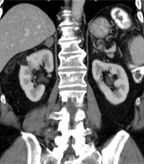Everolimus Reduces Size of Noncancerous Kidney Tumors
The mTOR inhibitor everolimus (Afinitor) has been found to significantly reduce the size of angiomyolipomas, the slow-growing benign tumors commonly associated with tuberous sclerosis complex (TSC) and sporadic lymphangioleiomyomatosis, according to the results of the phase III EXIST-2 study.
The mTOR inhibitor everolimus (Afinitor) has been found to significantly reduce the size of angiomyolipomas, the slow-growing benign tumors commonly associated with tuberous sclerosis complex (TSC) and sporadic lymphangioleiomyomatosis, according to the results of the phase III EXIST-2 study.

Renal angiomyolipoma: right kidney lesion in CT; source: Hellerhoff, Wikimedia Commons
“The mTORC1 inhibitor everolimus, also called Afinitor, was able to shrink the kidney tumor for patients with tuberous sclerosis complex,” said John J. Bissler, MD, Clark D. West Chair of Nephrology at Cincinnati Children’s Hospital Medical Center. “This genetic disease is caused by changes in a cell growth pathway that becomes more properly regulated when patients take this drug.”
According to the study, TSC affects about one to two million people worldwide. This double-blind, placebo-controlled study, the results of which were published in the Lancet, was the first to examine the effects of everolimus in TSC. Everolimus is currently FDA-approved for a variety of malignant cancers, including pancreatic neuroendocrine tumors, renal cell carcinoma, and HER2-negative breast cancer.
The study included 118 patients from 24 centers, aged 18 years or older who had at least one angiomyolipoma that was 3 cm or larger in diameter and a confirmed diagnosis of TSC or sporadic lymphangioleiomyomatosis. The patients were assigned 2:1 to receive 10 mg everolimus or placebo.
At data cutoff, researchers found an angiomyolipoma response rate of 42% for patients assigned everolimus compared with 0% in the placebo group (P < .0001). On average, the time to response was 2.9 months for patients in the experimental arm. In addition, patients assigned everolimus had a significantly longer time to angiomyolipoma progression vs those patients assigned placebo (P < .0001).
By week 24 of the study, angiomyolipomas had shrunk by at least 50% from baseline in 55% of patients assigned to everolimus, and by at least 30% in 80% of patients assigned everolimus. Patients in the placebo group had 0% reduction in angiomyolipoma size.
“These results offer hope for the nearly one million patients worldwide who have tuberous sclerosis complex renal disease,” Bissler said. “We hope that this therapy will help them preserve their kidney function and avoid life-threatening complications from these tumors.”
Treatment with everolimus resulted in an acceptable safety profile. The most common adverse events in the everolimus group were stomatitis (48%), nasopharyngitis (24%), and acne-like skin lesions (22%).
In an editorial that accompanied the article in the Lancet, Prasanna Sooriakumaran and Christopher J. Anderson, of the department of urology at St. George’s Healthcare NHS Trust, London, congratulated the researchers on the results of the study, but pointed out that the “relative costs of a maintenance treatment will also need to be weighted against those of radiological or surgical interventions.”
Despite the need to investigate cost, they wrote that the promising results “are likely to herald a new approach to the treatment of this rare but serious disease.”